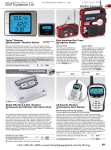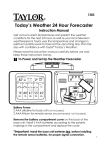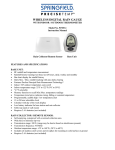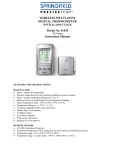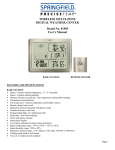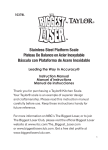Download Taylor 2753 User's Manual
Transcript
2753 Digital Wireless Rain Gauge & Thermometer Indoor/Outdoor Thermometer with Remote Rain Gauge Leading the Way in Accuracy® Required: Screw Driver & 4 ‘AAA’ Batteries Instruction Manual Welcome to the Taylor® Digital Wireless Rain Gauge and Thermometer. Simple, reliable, accurate… it allows you to monitor indoor or outdoor temperatures as well as rain fall from one room. While the base unit reads indoor conditions, the remote sensor wirelessly reports outdoor weather conditions back to the base unit for an all-in-one weather display. Plan your work day, play day, every day. Now that's smart! Table of Contents: Battery Installation....................................... 2 How to Set Up Your Rain Gauge............... 2-4 Where to Place Your Rain Gauge............. 3 How to Display Your Rain Gauge.............. 3 How to Read Your Rain Gauge................. 5 How to View Readings................................ 5 Rain Alert...................................................... 6 Rainfall History.............................................. 5 Temperature Readings................................ 6 Temperature Trend Indicators..................... 6 Temperature Alerts....................................... 7 Low Battery Indicators.................................. 7 Trouble Shooting.......................................... 7-8 Precautions.................................................... 9 Specifications................................................ 8 Warranty Information................................... 9 Battery Installation Base Unit Base Unit: The Base Display Unit is powered by 2 AAA batteries (not included). 1. Remove the battery compartment cover located on the back of the unit. 2. Install 2 AAA batteries. 3. Replace the battery compartment cover. 4. Remove any static cling label from the LCD screen. Important: Install batteries in the base unit before installing batteries in the rain cup sensor, or the units' transmissions may not properly connect. UP IN-OUT TEMP MODE ALERT Rain collection cup sensor: 1. Remove the 2 screws from the battery compartment cover on the bottom of the rain collection cup sensor and remove the cover. 2. Install 2 AAA batteries (not included) into the battery compartment. 3. Tip: Lithium batteries are recommended in extremely cold or hot locations. 4. Replace the battery compartment cover and the screws. Make sure the door is securely closed to prevent water leakage. 2 HISTORY Remote Rain Collection Cup How to Set Up Your Rain Gauge 1. Remove any static cling labels from the LCD screen and any tape from the base unit or rain collection cup. 2. Install 2 AAA batteries into the base unit (see Battery Installation section). 3. Install 2 AAA batteries into the rain collector cup sensor (see Battery Installation section). 4. Remove the 2 screws on the bottom of the rain cup sensor and remove the rain cup cover. 5. Remove any tape or cardboard from the rain cup pendulum to allow it to fill and empty when rainfall occurs. 6. Replace the rain cup cover and the 2 screws. DOWN RE-SYNC Tape or Cardboard B ry e r tt e a v o C How to Set Up Your Rain Gauge (cont.) 7. Place the base unit as close as possible to the rain cup sensor. 8. Press the “RE-SYNC” button on the back of the base unit. The base unit will search for a signal from the rain cup. The “ “ icon appears in the bottom left corner of the LCD to indicate a transmission signal has been sent. 9. The IN temperature reading appears when transmission is successful. 10. If the IN temperature does not appear with 3 minutes, press the “RE-SYNC” button again. If the IN temperature still does not appear, refer to the Troubleshooting Section. 11. The remote will then automatically transmit updated readings to the base unit every 45 seconds. TIP: Press ‘IN/OUT TEMP’ on the back of the base unit to switch between indoor and outdoor temperatures. Where to Place Your Rain Gauge Base unit location: Place the unit indoors in a well-ventilated location away from direct sunlight. Rain Collection Cup Sensor location: 1. Place the rain collection cup sensor on a level, horizontal surface for accurate readings. 2. If desired, use the 2 included screws to mount to a solid surface (such as a fence post or a garden shed. Or use the 2 included spikes to mount to the ground. (Please note the rain cup sensor must be horizontally upright for accurate rainfall readings.) 3. The transmission range of the rain cup sensor is 100 feet. The effective transmission range is vastly affected by obstacles such as walls, sheds, trees, etc. Try various set ups for the best results. Shorten the distance between base and rain cup sensor units when necessary. Place the sensor in a dry, shaded area. Direct sunlight will heat the casing and inflate temperatures readings. Tip: Keep the rain cup sensor at least 3 feet from any obstructions which may affect rain collection. For example, do not place the sensor under a tree, as water dripping from leaves into the rain cup will overstate actual rainfall. Important: Though the rain cup sensor is weather- and frost-resistant, it should never be completely submerged in water or left outside during snowy weather. Also please note the transmitter should not be left outdoors in temperatures at or below -4°F (-20°C). If the temperature drops to this level, move the rain cup sensor to an indoor area. Both the rain cup sensor and the base unit should be kept at temperatures between -4°F (-20°C) to 140°F (60°C). Extreme temperatures outside this range can permanently damage internal circuitry. How to Display your Rain Gauge Table top – use the Table Stand on the back of the base unit. UP IN-OUT TEMP MODE ALERT Wall – use the keyhole on the back of the base unit. DOWN RE-SYNC HISTORY Wall Mount Keyhole Table Top 3 How to Set Up the Base Unit In the following order, you may set the calendar, time, 12 or 24 hour mode, °F or °C temperature scale, and the measurement units for rainfall (inches or millimeters). To set up, use the buttons on the back of the base unit. .1 Press and hold “MODE” for 3-4 seconds. The year digits flash. .2 Press “UP” or “DOWN” to change the year. Press “MODE” to enter. The month digit flashes. .3 Press “UP” or “DOWN” to change the month. Press “MODE” to enter. The date digit flashes. .4 Press “UP” or “DOWN” to change the date. Press “MODE” to enter. The hour digits flash. .5 Press “UP” or “DOWN” to change the hours. Press “MODE” to enter. The minute digits flash. .6 Press “UP” or “DOWN” to change the minutes. Press “MODE” to enter. The 12/24 hour clock option flashes. .7 Press “UP” or “DOWN” to change the 12/24 hour clock option. Press “MODE” to enter. The °F/°C temperature scale option flashes. .8 Press “UP” or “DOWN” to change the °F/°C temperature scale option. Press “MODE” to enter. The rainfall reading option flashes. .9 Press “UP” or “DOWN” to change the rainfall reading option (INCH for inches or MM for millimeters). Press “MODE” to enter. .10 Set Up is complete. Tip: Hold down “UP” or “DOWN” to advance the digits quickly. 4 How to Read Your Rain Gauge Rain collection cup sensor: outdoor readings The rain collection cup sensor will transmit weather conditions from its location back to the base unit. The base unit can display indoor conditions from its location and outdoor conditions from the rain collector cup sensor. Base unit: Indoor and Outdoor readings How to View Readings Press “MODE” to toggle between the clock, calendar, rainfall rate and total rainfall displays. Minimum/Maximum Temperature/Rainfall Readings Your Wireless Rain Gauge will store the last recorded high and low temperatures and rainfall levels over a 24 hour period. The 24 hour period starts when the batteries are installed. The daily record will update after a 12:00 am to 11:59 pm period (based on the manual clock setting). 1. Press “MAX/MIN” button on top of the base unit to toggle through these daily readings: • Indoor maximum temperature • Indoor minimum temperature • Outdoor maximum temperature • Outdoor minimum temperature • Rainfall maximum level • Rainfall minimum level Top of Base Uint 2. To manually clear any minimum or maximum readings, press “CLEAR” on the top of the base unit while a reading is displayed. The reading will reset. Otherwise, the units will automatically reset at 11:59 pm (based on the manual clock setting). Rainfall History Your Wireless Rain Gauge will store the rainfall history for: • Last hour • Last 24 hours • Daily rainfall (current day plus up to last six days) • Weekly rainfall (current week plus up to last six weeks) • Monthly rainfall (current month plus up to last six months) Note: The recording period starts when the batteries are installed. Upon setup, the base unit will automatically display the Daily Rainfall history. Press “HISTORY” to toggle through these readings: • Weekly rainfall • Monthly rainfall • Last hour rainfall • Last 24 hour rainfall • Return to Daily rainfall The Rainfall History Bar graph displays in increments from 0.1” to 6.0” (10 mm to 60 mm). Most often the actual rainfall reading will fall between increments. The bar chart will show the last increment that was reached. For example: if the actual rainfall is 0.8” (20 mm), the bar graph will not show 1.0” until the actual rainfall total reaches 1.0” (25 mm). 5 Rainfall History (continued) Additional detailed daily, weekly and monthly history rainfall data may be viewed. Press “HISTORY” to toggle through Weekly, Monthly, Last Hour, and Last 24 Hour rainfall readings. Press and hold “HISTORY” while the desired reading is displayed, The “0” (current) bar graph will appear, and the data will replace the time digits. Press “UP” or “DOWN” to scroll through the daily, weekly or monthly data. Top of Base Unit The rainfall reading is accumulative. To clear/reset rainfall data, press “CLEAR” while that data (weekly, monthly, etc.) is displayed. Please note: The “0” on the bar chart indicates the current period. A -1,-2, etc., indicates the prior periods. The X10 MM icon appears when the unit is set to millimeters. One bar graph will appear for every 10 millimeters of rainfall. Rain Alert Icon The rain alert icon appears when the rain collection cup is filling with water from any source, such as rainfall or a sprinkler. Temperature Readings Upon setup, the base unit will first show the indoor temperature at the base unit location, and then it will switch to the outdoor temperature of the rain cup sensor location. To switch between Indoor/Outdoor readings, press “IN-OUT TEMP” on back of the base unit. An “IN” icon indicates indoor readings. An “OUT” icon indicates outdoor readings. Auto Scroll feature – the base unit can be set to automatically toggle between indoor and outdoor temperature readings. (Rainfall reading will remain steady, since they are only calculated outdoors.) To activate Auto Scroll, press and hold “IN-OUT TEMP” on the base unit for 3-4 seconds. The auto scroll icon ” ” appears on the base unit LCD readout above the IN/OUT icons. To deactivate the Auto Scroll feature, press and hold “IN-OUT TEMP” on the base unit for 3-7 seconds. The Auto Scroll icon ” ” will disappear. Press “IN-OUT TEMP” to switch between indoor or outdoor readings if desired. Temperature Trend Indicators Your Wireless Rain Gauge will indicate if temperatures are rising, falling, or steady. Indicates Rising Temperatures readings (temperatures have gone up more than 2 degrees in an hour) Indicates Steady Temperature readings. Indicates Falling Temperatures (temperatures have gone down more than 2 degrees in an hour) 6 Temperature Alert Your Wireless Rain Gauge has a temperature alert feature. When either the indoor or outdoor temperature exceeds the high or low pre-set limits, an alarm will sound for five seconds, repeating every minute. An alert and arrow icons will also flash to indicate the temperature has reached the high or low limit. To Set a High/Low Temperature Alert: 1. Press and hold “ALERT” until the alert, up arrow and “IN” icons appear and the alert temperature digits flash. 2. Press “UP” or “DOWN” to change the indoor alert temperature high limit digits. 3. Press “ALERT” to select the displayed temperature high limit. 4. Press “ALERT” again to begin setting the indoor temperature low limit digits. The display will show a down arrow instead of an up arrow. 5. Press “UP” or “DOWN” to change the indoor alert temperature low limit digits. 6. Press “ALERT” to select the displayed temperature low limit. 7. Press “ALERT” again to begin setting the outdoor temperature high limit digits. The display will show an “OUT” icon instead of an “IN” icon and an up arrow instead of a down arrow. 8. Press “UP” or “DOWN” to change the outdoor alert temperature high limit digits. 9. Press “ALERT” to select the displayed temperature high limit. 10. Press “ALERT” again to begin setting the outdoor temperature low limit digits. The display will show a down arrow instead of an up arrow. 11. Press “UP” or “DOWN” to change the outdoor alert temperature low limit digits. 12. Press “ALERT” to select the displayed temperature low limit. 13. Press “ALERT” a final time to confirm the temperature limits. The limits are set. NOTE: The temperature limit increments are 1.8°F (1.0°C). To View a High/Low Temperature Alert 1. Press “ALERT” after setting the temperature alert limits (see previous section). The “ALERT” icon will appear. 2. An alarm will sound when a temperature is higher or lower than the set temperature limit. Press “ALERT” to stop the alarm. The alert icon will stop flashing. The arrow icon will continue to flash to indicate the set high/low temperature limit is too high or low. 3. The alarm will sound again if the set high/low temperature falls back within the high/low limit. 4. To deactivate the alarm, press “ALERT” until the alert icon disappears. Low Battery Indicator A“ “ with the “IN” icon indicates the batteries on the indoor base unit are running low and should soon be replaced. A“ “ with the “OUT” icon indicates the batteries on the outdoor rain collection cup sensor are running low and should soon be replaced. Trouble-Shooting Disconnected Signals If the receiver unit does not receive a transmission from a remote channel for 1 hour, the display will show dashes. To correct this problem: 1. Check that the rain gauge collection cup is properly positioned, within the appropriate transmission range. Transmissions are vastly affected by building materials and where the base unit and rain collection cup are positioned. Try various set ups for the best results. Shorten the distance between base unit and rain collection cup units when necessary. 2. Check to make sure the transmission path is clear of obstacles and interference. 3. If new batteries are faulty on the initial installation, install fresh batteries. Low Battery Icon will warn you if the base unit or rain cup collector batteries have lost their charge. Replace the batteries when necessary. 4. Press RE-SYNC on the back of the base unit to send a transmission signal to the base unit. 7 Trouble-Shooting (continued) Transmission Collision Signals from other household devices, such as doorbells, home security systems and entry controls, may interfere. This is normal and does not affect the general performance of this product. The transmission will resume once the interference recedes. Note: This equipment has been tested and found to comply with the limits for a Class B digital device, pursuant to Part 15 of the FCC Rules. These limits are designed to provide reasonable protection against harmful interference in a residential installation. This equipment generates, uses and can radiate radio frequency energy and, if not installed and used in accordance with the instructions, may cause harmful interference to radio communications. However, there is no guarantee that interference will not occur in a particular installation. If this equipment does cause harmful interference to radio or television reception, which can be determined by turning the equipment off and on, the user is encouraged to try to correct the interference by one or more of the following measures: --Reorient or relocate the receiving antenna. --Increase the separation between the equipment and receiver. Modifications not authorized by the manufacturer may void users authority to operate this device. FCC ID: VVG53631638TX Problem Solving 1. If the LCD readout on the base unit is faint, replace the batteries. 2. If outdoor temperature does not display on the base unit: a) Remove and reinstall all batteries; b) Use fresh batteries; c) Place the rain collection cup sensor closer to the base unit; d) Position the base and rain cup sensor so that the transmission path is free of any obstacles, such as buildings, trees, etc. Try to have no more than 2 or 3 walls between the units. 3. If synchronization is lost between the base unit and remote sensors: a) The base unit displays “--.-C” or “---.in”. b) Press “RE-SYNC” on the base unit. The base unit will search for the rain cup sensor signal for 3 minutes. If the outdoor temperature does not display after 3 minutes, press “RE-SYNC” again. If attempts to synchronize fail, check that there are no physical obstructions between the units that might block transmissions, such as sheds or trees. If necessary, shorten the distance between the receiver and remote units. Remove all the batteries from the units, wait at least 10 seconds, and then install the batteries again. Repeat Set-Up instructions to re-synchronize the units. Specifications • Range of temperature measurement: Base unit (indoor only): 14°F to 158°F (-10°C to 70°C) Rain collection cup sensor: -4°F to 158°F (-40°C to 70°C) • Resolution: 0.1 degree for temperature • Transmission frequency: 433 MHz • Temperature trends: rising, falling or steady • Minimum/Maximum: temperature/rainfall records • Clock: 12 or 24 hour • Low Battery Indicator • Transmission: Max. 100 ft (30m) open area • Power: 2 AAA alkaline batteries (not included) for base unit and 2 AAA alkaline batteries for rain cup collector (not included) 8 Precautions 1. The base unit is intended for indoor use only. It is not sealed against moisture and could be damaged if used outdoors. 2. Do not immerse the base unit in water. If you spill liquid on it, dry immediately with a soft, lint-free cloth. 3. Though the rain collection cup sensor is weather-resistant, it should not be left outdoors in snow or at temperatures at or below -4°F (-20°C). If the temperature falls below this point or if snow accumulates, move the rain cup sensor to an indoor area. Otherwise, permanent damage to the transmitter's internal circuits may occur. 4. Though the remote rain collection cup sensor is weather-resistant, it should be placed away from ice or snow, and should never be submerged in water. 5. Do not clean the unit with abrasive or corrosive materials. This may scratch plastic parts and corrode electronic circuits. 6. Do not subject unit to excessive force, shock, dust, temperature or humidity. This may result in malfunction, shorter electronic life span, damaged battery or distorted parts. 7. Do not tamper with the unit's internal components. Doing so will invalidate the warranty on this product and may cause damage. The unit contains no user-serviceable parts. 8. Do not mix old and new batteries. Do not mix Alkaline, carbon-zinc (standard) or NickelCadmium (rechargeable) batteries. Do not dispose of batteries in fire. Batteries may explode or leak. Remove the batteries if the units will not be used for a long period of time. 9. Always read the instruction manual before operating this product. 10. Due to continuous product improvements, the example illustrations shown in this manual may differ from the actual display. One Year Warranty This product is warranted against defects in materials or workmanship for one (1) year for the original purchaser from date of original purchase. It does not cover damages or wear resulting from accident, misuse, abuse, commercial use, or unauthorized adjustment and/or repair. Should this product require service (or replacement at our option) while under warranty, do not return to retailer. Please pack the item carefully and return it prepaid, along with store receipt showing date of purchase and a note explaining reason for return to: Taylor Precision Products 2220 Entrada Del Sol, Suite A Las Cruces, New Mexico 88001 www.taylorusa.com Customer Service: 1-866-843-3905 There are no express warranties except as listed above. This warranty gives you specific legal rights, and you may have other rights which vary from state to state. For additional product information, or warranty information in Canada or elsewhere outside the USA, please contact us through www.taylorusa.com. Made to our exact specifications in China. © 2010 Taylor Precision Products and its affiliated companies, all rights reserved. Taylor® and Leading the Way in Accuracy® are registered trademarks of Taylor Precision Products and its affiliated companies. WeatherGuide™ is a trademark of Taylor Precision Products and its affiliated companies. All rights reserved. CP2753 04.10 9












